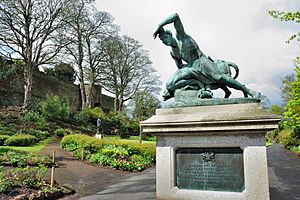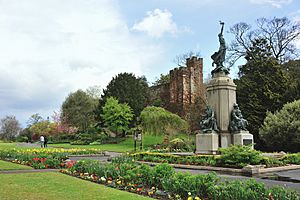Northernhay Gardens facts for kids
Northernhay Gardens is a special park located in Exeter, Devon, England. It sits right next to the historic Rougemont Castle. Imagine, this park is the oldest public green space in all of England! It was first created way back in 1612 as a lovely place for the people of Exeter to walk and enjoy nature. Today, Northernhay Gardens is recognized as an important historical site and is carefully looked after by the Exeter City Council.
Contents
Discover Northernhay Gardens
A Park with Ancient Roots
This area has a very long history! Even in Roman times, stone was taken from here to build the city walls of Exeter. If you visit, you can still see parts of the original Roman wall. What's even cooler is that the gardens also contain the only remaining section of a Saxon town wall visible in England. The park itself is shaped like a crescent moon. To the north, you'll find the main railway line and Exeter Central railway station. To the south, it's bordered by the old castle and Rougemont Gardens. You can enter the gardens from Northernhay Place on the east side or Northernhay Gate on the west.
A Journey Through Time
When Northernhay Gardens was first made in 1612, it was a peaceful "pleasure walk." But its calm was broken during the Civil War in 1642. To protect the city, large defensive ditches were dug, and the park was damaged. After the war, around 1664, the city worked hard to bring the park back to life. They planted hundreds of young elm trees and created new gravel paths. Since then, it has always been a much-loved green space for everyone in Exeter. For many years in the 17th and 18th centuries, locals even called it "Norney" as a friendly nickname!
Statues and Special Memorials
In the late 1800s, specifically around 1860, the gardens got a big makeover. Many important statues were added to honor key figures from Exeter's past. One famous statue is The Deer Stalker, created in 1875 by a talented artist named E. B. Stephens. This artwork was even shown in a famous art exhibition in 1876! Stephens also sculpted statues of John Dinham, who was a kind person who helped many people in the community, and Sir Thomas Dyke Acland, 10th Baronet, another important local figure.
You can also see a statue of Stafford Northcote, an important leader from the 1800s, sculpted by Joseph Boehm in 1887. The Volunteer Memorial, built in 1895, remembers the start of the 1st Rifle Volunteers group in 1852. The Exeter War Memorial, created by local sculptor John Angel, was finished in 1923. This memorial is a place to remember those who served their country. The gardens also have a lovely bandstand, where music events are sometimes held.
Nature and Modern Fun
In the middle of the 1900s, many of the tall elm trees that lined the main paths sadly got sick with a plant disease called Dutch Elm Disease. These trees had to be removed. But don't worry! New trees and plants have been added since then to make sure the gardens are colorful and interesting all year round. Northernhay Gardens offers amazing views across much of the city. It's also a popular spot for different events and activities throughout the year, making it a lively place for everyone to enjoy.



